Samsung, connecting your everyday life.

How Samsung is helping you live a Smart life by connecting everything around you.
Samsung Electronics first launched a Smart home initiative back in September 2014 at IFA, one of the largest electronics exhibitions in the world. As to the keynote speech given by the CEO, Samsung believed that Smart home was the next big thing in the electronics market.[1]
At the IFA last year, Samsung introduced SleepSense, a device that you slip beneath your mattress and it tracks your sleeping pattern and generates a sleep report every morning with advice on how to sleep better at night. Samsung believes that this will also be an integral part of materializing Smart home.[2]

 <Samsung’s Smart Home showroom at IFA 2014 / Samsung’s Sleepsense at IFA 2015 >
<Samsung’s Smart Home showroom at IFA 2014 / Samsung’s Sleepsense at IFA 2015 >
And finally at this year’s IFA, Samsung released ‘Family Hub’ which will become a key driver in expanding the Smart home initiative. Family Hub is the central platform that is installed in your refrigerator. Samsung selected refrigerators as the center of communication inside a household where family members gather to drink water or leave a sticky note to each other.[3]
Family Hub gives you information on how long has the food been stored and how much time you have left before certain items expire. It also automatically orders food and provides recommendations on the recipes. A camera inside the fridge analyzes everything for you. Through Smart Hub, you can also access the washing machine and the air conditioner, and of course, it is connected to your smartphone. The network hub for all these new features is based on the technology acquired when Samsung bought SmartThings in 2014.

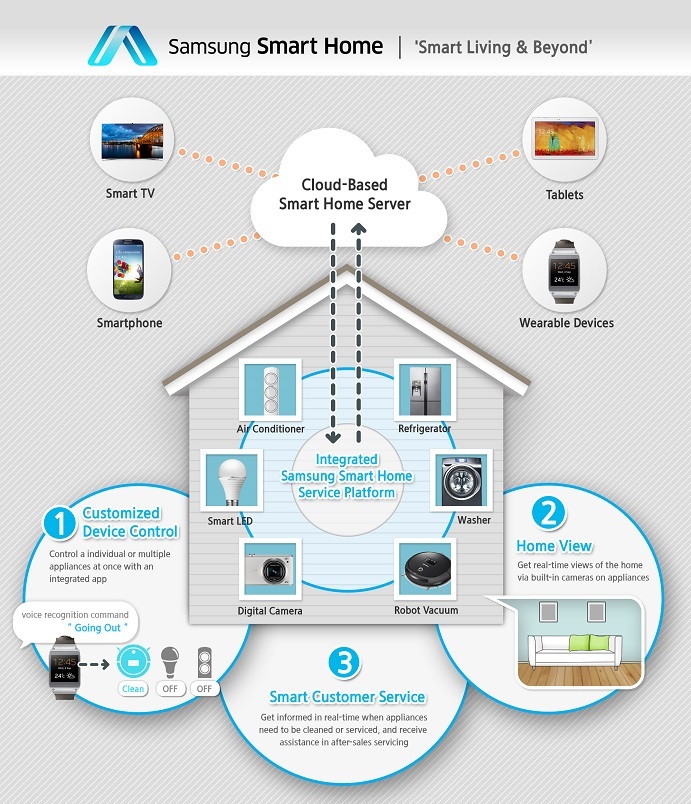 < Samsung Family Hub / Samsung Smart Home >
< Samsung Family Hub / Samsung Smart Home >
Samsung saw the opportunity in the Smart home market early on. The company had three major business units; mobile communication, semiconductors, and home appliances. Each business unit grew exponentially during the early 2000s and became market leaders in all three. But the company was missing the synergy between the business units and was aggressively looking for was to connect the products that it offered to change the lifestyle of its customers.
Samsung has been a market leader, not only in Smartphones but also in home appliances such as TVs, washing machines, and refrigerators. Samsung also acquired a luxury built-in brand Dacor to strengthen its product portfolio in the home appliances market. The competitive edge for Samsung to enter the Smart home market was their existing product line. But despite having a powerful “hardware” base, the company still lacked a software platform, a platform that can maximize the synergy between its existing hardware. So Samsung shifted its strategy towards investing and acquiring companies that had the capability to provide the software.
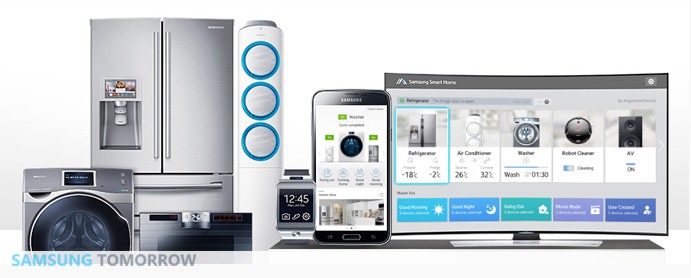 < Connecting Home Appliances >
< Connecting Home Appliances >
Internet of Things (IoT) seemed to provide a near-term solution. A dynamic industry was evolving around IoT technology. For Samsung, the development in IoT was the perfect chance to compliment the companies existing manufacturing business.
Samsung started focusing in IoT by acquiring SmartThings in 2014. The expected synergy between the existing product line and the open IoT platform that SmartThings brought into the picture. Samsung is embedding SmartThings technology in all of its new Smart TVs as well as some major appliances and other electronics. Samsung’s effort in connecting appliances through an IoT platform is not only limited to the company’s products. In the second half of 2016, Samsung introduced “SmartThings Hub” which will connect not only Samsung products but also appliances from other brands to the Smart Home Network.
Going further with IoT, Samsung launched its own IoT chipset and cloud development platform called ‘Artik,’ and this year the company announced a $1.2 billion R&D initiative in IoT. Samsung ARTIK is an open platform designed to enable faster and simpler development of new enterprise, industrial and consumer applications for the Internet of Things. The platform is designed to deliver a superior end-to-end solution with integrated modules featuring best-in-class security, cloud connectivity, local intelligence and a wealth of partner applications through its rich developer ecosystem.[5]
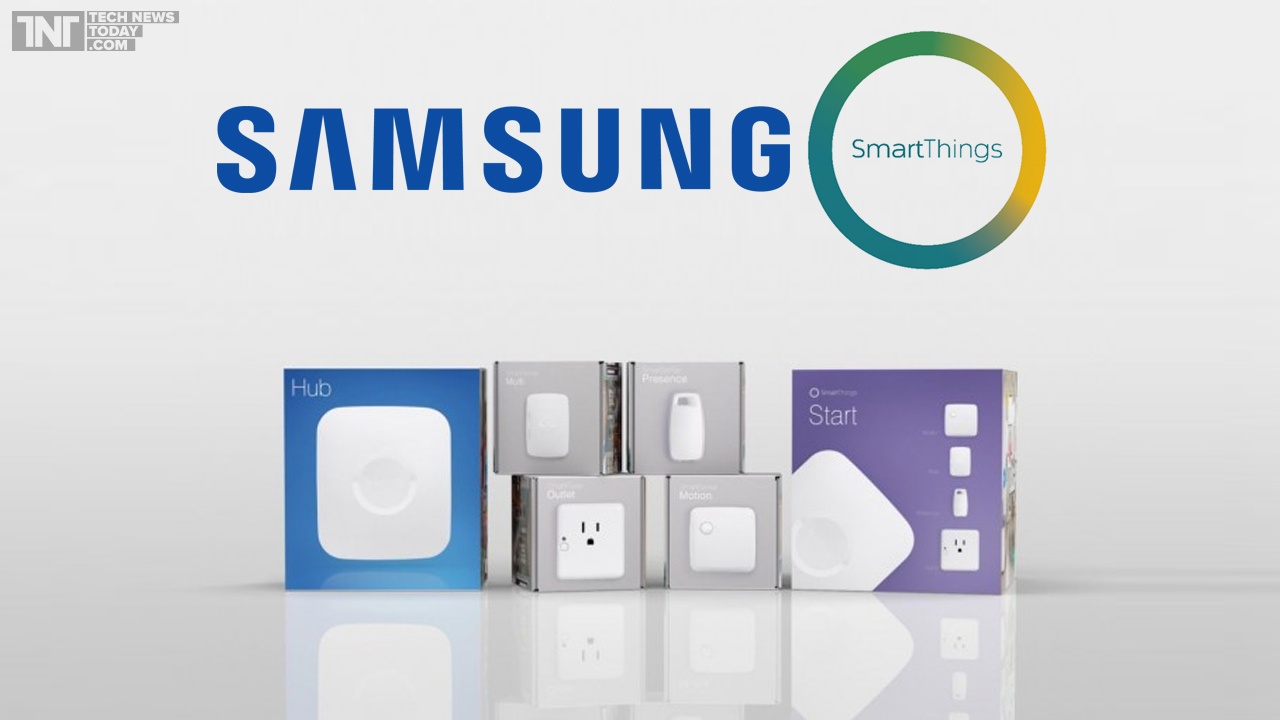
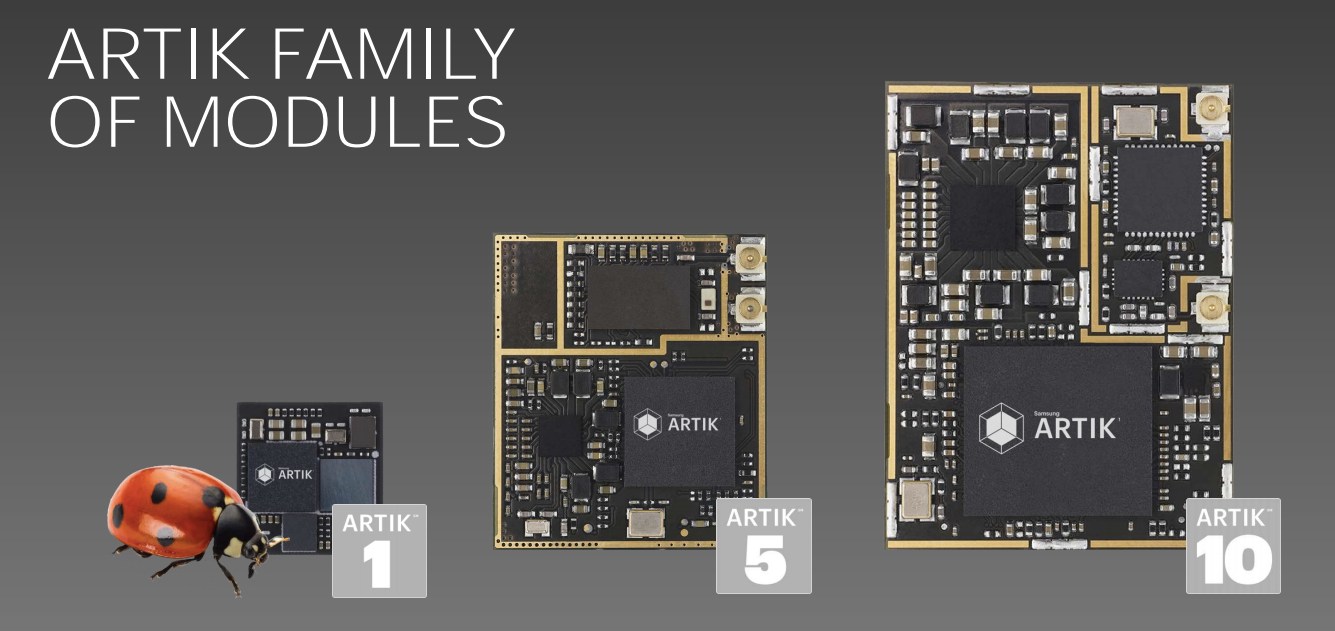
< SmartThings Hub / Samsung Artik >
As in other technology waves, both incumbents and new players have opportunities. Digitization blurs the lines between technology companies and other types of businesses.[6] In Samsung’s case, digitization was a key driver in the strategic expansion of its business model.
Samsung recently acquired Harman International, an automotive technology company that is well-known for its navigation system and audio products. In a time when the mobile market is undergoing changes and slowing down, connected cars could be the next platform for technology innovation. The vehicles are also likely to tap into corporate IT resources — even for those outside of the automotive business. Connected vehicles are capable of capturing large amounts of data and will play a key role in the burgeoning internet of things (IoT) ecosystem. [7] This will be the new next big thing for Samsung and a big step closer to connecting all the elements in everyday life.
[ Word Count : 785 ]
[1] https://news.samsung.com/global/how-samsungs-smart-home-initiative-will-change-your-future-home
[2] https://www.cnet.com/products/samsung-sleepsense/preview/
[3] Interview with DK Lee, marketing manager of Family Hub project.



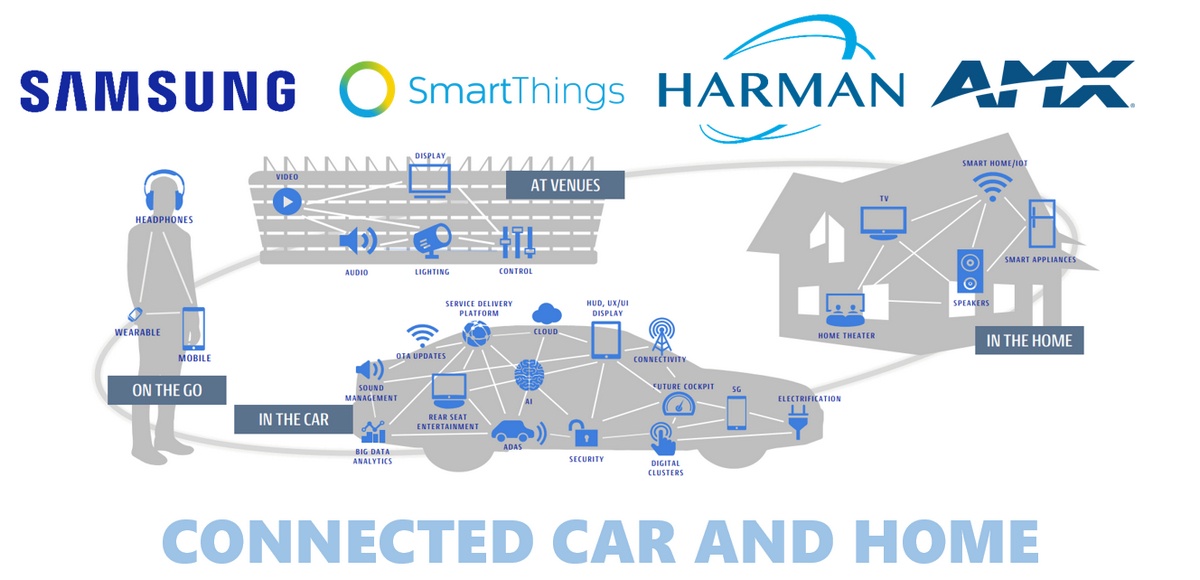
This is an amazing article! So, fascinating to know that the market leader in smartphones, Samsung has taken it one notch up and is investing in digitization solutions through acquisition of technology and companies. The initiatives in the space of Smart Home Hub through the acquisition of SmartThings opens up enormous possibilities to invent and innovate in the space of IoT whether be it security, smart intelligence etc. Harman looks very promising acquisition and looking forward to seeing the next big innovations by Samsung in the automotive space.
Great post! Given that there are so many companies competing in the ‘connected home/device’ space, I think it will be interesting to see which model wins out: having the absolute best performance / being first mover on one specific product (e.g. Nest for thermostats, Jawbone Up for exercise and sleep tracking) or owning an entire environment (the home, or the office) with a series of connecting products that are fast-followers. The Family Hub tech you mentioned for monitoring food storage and recommending purchases appealed to me in particular – becoming a part of a core activity for families is a great way to embed yourself into consumer lives.
Thank you so much Jaydn for a great article – it is interesting to see how Samsung started seeing more opportunities in IoT and trying to integrate different business units they have. Although I agree the potential of IoT as well as integrated solutions like Smart Home, it is also a difficult concept for the consumers to understand. How does Samsung try to make their customers adopt to these concepts? (Similar discussions we had on product diffusion in Marketing class)
Interesting concepts from Samsung here. However, I can’t help but wonder how much some of this IoT technology will really take off in the near future, especially the Smart Home/appliance technology. I understand the usefulness of adjusting the A/C from wherever you are – at home or not – but how much use is it to be able to remotely access your washing machine? People still need to physically load clothes into the washing machine, and then they need to physically move it to the dryer when the washer is done. In addition, although it’d be handy to peek at your refrigerator from the grocery store to check whether you need to pick up more milk, how does it really tell how long things have been in the fridge, especially if you rearrange items regularly? Also, given that people tend to keep appliances almost a decade, will that make adoption slow?
Lastly, doesn’t connecting everything in your home and in your car make people increasingly vulnerable to hacking? (I mean both data stealing and the ability to hack and shut down a person’s home or car.)
This is very impressive and innovative move by Samsung. l find it a little bit peculiar that Samsung chose refrigerator as a centerpiece for the “Family Hub” model. One would assume that they will surely use the phone to connect people. Instead, Samsung decided to revolutionize a more traditional household device.
Furthermore, Samsung continues to revolutionize another traditional hardware. Choosing car is a perfect option. I think car is one of the industry where improvement was limited since its creation. It will be very interesting to see how Samsung connects everything together.
Samsung’s decision to make the refrigerator the hub of the “connected home” is genius. However, an item like a refrigerator or washing machine is very expensive and the purchase only occurs after 10 or more years. This creates a huge barrier for entry for new users who want to start to build a more digital home, but don’t have the excess cash to spend on a brand new set of appliances. Has Samsung considered creating a smart device like the Amazon echo or Google home to ease customers into home automation or does Samsung simply plan to link into these devices? Additionally with items like refrigerators or washing machines that have a long lifetime, how does Samsung plan to make these refrigerators and smart devices remain relevant as technology changes?
Thanks Jaydn for sharing another insightful Samsung post! These solutions would touch upon so many parts of our lives, so it was a very intriguing read. I am impressed that Samsung choses to make the big R&D investment based solely on projected future growth of IoT.
I wonder how quickly their investments will pay off. How many people will actually go out and buy a “connected home”? To Taka’s point, is it something that consumers will actually understand? When consumers don’t understand a value proposition, they will not pull out their wallets and pay for it. Today, even the most basic home monitoring kit costs $249 to buy (https://shop.smartthings.com/kits/samsung-smartthings-home-monitoring-kit), so quite pricey. I am curious to see how Samsung plans to go to market with these solutions in the U.S.
Furthermore, it seems that the big opportunity for IoT isn’t in connecting the Home. While McKinsey projects the IoT market to become worth $4 to $11 trillion in 2025, the Home is “only” $0.2 to $0.3 trillion of that.
Again, very interesting read. I look forward to retiring with these solutions in place, in 40 years.
Great article. I think it is really neat that Samsung is able to connect all of these products together. I also agree that connected cars really make sense as an addition to their current portfolio. Since companies are making investments into electric cars and autonomous cars, I think it makes sense to integrate new cars into the smart home system.
Also, for me, the most exciting aspect of smart homes is the ability to reduce energy consumption (http://www.smarthome.com/sc-save-energy-the-smarthome-way) and the possible cost savings for the customers(https://www.electronichouse.com/home-energy-management/4-smart-home-technologies-can-reduce-electricity-bills/). I think that older homes are inefficient in terms of energy management, so I see IoT as a way to improve energy management. So, the company should definitely market the possible cost and time savings for using these products.
Lastly, are these platforms know to be secured in a cyber security sense? Cyber security issues might slow the adoption of IoT technologies.
I find the home/life automation topic to be very fascinating. It is great the steps Samsung is taking to sync all facets of everyday life, and the push towards a fully integrated car system would be great as well. All of this connectivity makes me wonder about the safety of such ventures though. Given that much of your data is already tracked, I could see problems with one being able to track the location of say their car, on an appliance that is in the consumers house. It could pose a security risk. As we move towards a more connected world the benefits are definitely clear, but I wonder how we well we have assessed the risks of always being connected.
Jaydn, your identification of Samsung’s product diversification and pursuit of cross-product synergies was very insightful and gave me some good take aways. I am curious how well Samsung is able to use innovations developed for its smart phones and TVs in its home and auto products. As we saw in the IBM case, Watson’s innovation S-curve eventually stalled out because it was too specific to be used easily in other applications. I am very interested to see how Samsung uses data analytics in its IoT products and what Samsung will innovate next. Thanks for sharing!